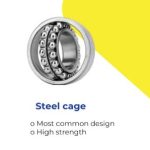Planetary gears are utilized in gearboxes to power anything from basic plant machinery to cutting-edge electric vehicles and are at the core of contemporary engineering. Thousands of years ago, the straightforward design of a central drive and orbiting gears was created to simulate the motions of the planets.
What is a planetary gearbox?
An instrument having aligned input and output shafts is a planetary gearbox. The most efficient way to transmit the most torque is through a planetary gearbox.
In addition to being compact, planetary gearing also has an in-line shafting and a cylindrical assembly.
Three different types of gear make up a planetary gear set:
- Sun gear,
- Planet gear, and
- Ring gear.
Where Can You Find Planetary Gears?
Planetary gears are typically used in applications where space is confined because they are smaller than other types of gearboxes. They are also the foundation of the hydraulic planetary automatic transmission, which is the most common type of automatic transmission. Applications:- Wheel drives
- Track drives
- Conveyors
- Pumps
- Drilling drives
- Cutter head drives
Why are planetary gears used?
Planetary gearing is used in challenging applications because the three planet gears are evenly distributed around the sun. They are more durable and power dense, allowing them to handle higher torques and reductions in a smaller, more compact package. Because of Planetgear’s unique self-aligning properties, they can also withstand higher shock loads and overhung loads. Double Row Full Complement Cylindrical Roller Bearing for Planetary gears Full complement cylindrical roller bearings with no outer ring are commonly used in planetary reducer gears. Reducers are essential devices used by a variety of machinery and equipment. To rotate and achieve long life, the bearings must meet the requirements of high speed and stability under various working conditions. Full complement cylindrical roller bearings without an outer ring, which use the inner hole of the gear as the outer ring and outer raceway of the bearing to simplify the host design and save space. The complete roller design can achieve the maximum rated load in a small area, and the average increase in effective load should be between 15% and 20%.Full complement two-row CRB designs are different because:
- No cages to hold rollers
- No outer race
- Maximum number of rollers vis-a-vis any CRB
- Non-separable
- High efficiency
- Compact construction
- High power density
- Easy to fit
- Long life



















